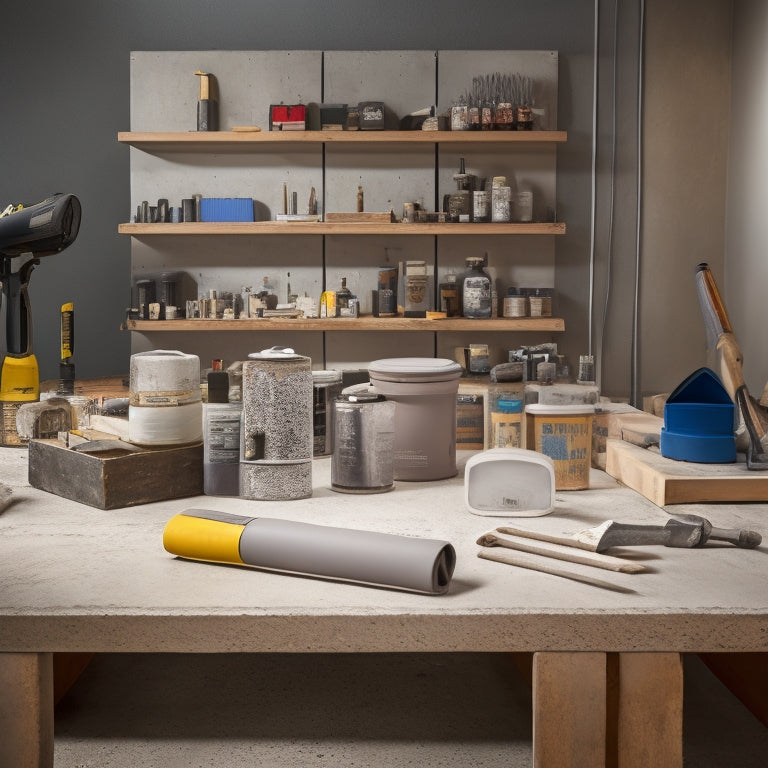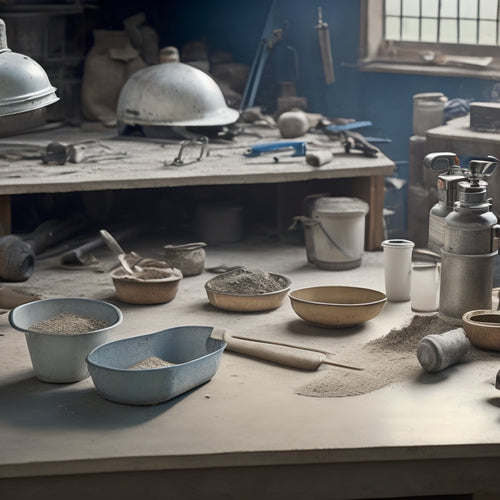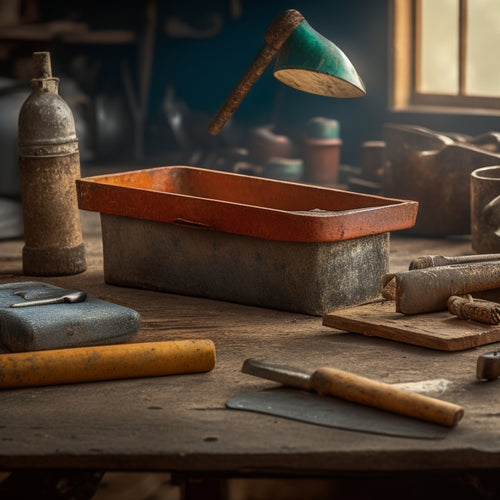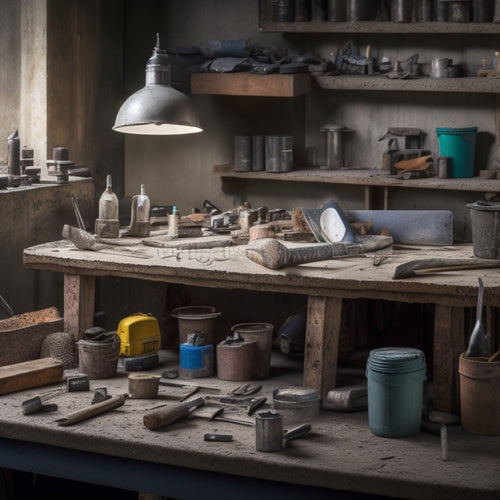
10 Best Tools for Effective Concrete Sealing
Share
You'll want to equip yourself with the right tools to guarantee a successful concrete sealing project. Start with a pressure washer for deep cleaning, then use sealing brushes for cinder blocks and cleaning solvents for tool maintenance. Next, choose the right applicator tools, such as concrete sealer sprayer options, sealant applicator guns, and notched trowels for even coating. Don't forget essential safety gear, including general safety gear and a table mask. Finally, utilize measuring cups for accurate mixing and lint-free rags for a smudge-free finish. Now that you've got the essentials, you're ready to master the techniques that take your concrete sealing project to the next level.
Key Takeaways
• Use a pressure washer for deep cleaning to remove dirt, grime, and old sealant residue, promoting improved adhesion for new sealant.
• Select the right application tool, such as a handheld sprayer or notched trowel, to achieve a uniform and precise sealant coat.
• Optimize technique by adjusting trowel angle and flow rate to ensure a consistent and even coating that meets specifications.
• Wear essential safety gear, including goggles, gloves, and a mask, to protect yourself from harsh chemicals and debris.
• Utilize lint-free rags and measuring cups to prevent contamination and ensure accurate mixing, resulting in a flawless finish.
Essential Sealing Brushes for Cinder Blocks
What kind of brush will effectively reach the crevices of your cinder blocks to guarantee a thorough seal? When it comes to sealing your cinder blocks, you need a brush that can get into the nooks and crannies to ascertain a watertight seal.
You'll want to take into account using a brush with stiff bristles, such as a wire brush or a brush with nylon bristles, to effectively remove dirt and debris from the cinder block's surface.
For ideal results, prepare your cinder blocks by cleaning them with a wire brush to remove any loose material. This will secure a strong bond between the sealant and the cinder block.
When selecting a sealing brush, look for one with angled bristles that can reach into corners and crevices. You may also want to take into account using a brush with a long handle to reduce strain on your back and arms.
There are various sealing brush types available, including natural fiber, nylon, and wire brushes. Each type has its own advantages and disadvantages, so it's vital to choose the right one for your specific project.
Pressure Washer for Deep Cleaning
Before applying a sealant, use a pressure washer to deep clean your cinder blocks, blasting away dirt, grime, and old sealant residue that can compromise the new seal's adhesion. This step is vital to guarantee a strong bond between the concrete and the sealant.
You'll want to choose the right pressure washer type for the job, such as a gas-powered or electric model, depending on the size of your project and the level of power you need.
Using a pressure washer offers several benefits, including:
-
Efficient cleaning: Pressure washers can cover large areas quickly, saving you time and effort.
-
Deep penetration: The high-pressure stream can reach into crevices and pores to remove deeply embedded dirt and grime.
-
Improved sealant adhesion: By removing old sealant residue and dirt, you'll create a clean surface for the new sealant to bond to, guaranteeing a longer-lasting seal.
Concrete Sealer Sprayer Options
With your concrete surface now clean and free of debris, you're ready to apply a sealant, and the right sprayer can make all the difference in achieving an even, consistent coat.
When it comes to concrete sealer sprayer options, you have several types to choose from, each designed for specific application techniques. Handheld sprayers are ideal for small to medium-sized areas, providing precision control and ease of use. Backpack sprayers, on the other hand, are perfect for larger areas, offering increased capacity and reduced fatigue. You may also think about using a cart-mounted sprayer for added convenience and mobility.
Regardless of the sprayer type you choose, it's crucial to reflect on the nozzle size and material. A wider nozzle is best for applying a thicker coat, while a narrower nozzle is ideal for achieving a more precise, detailed application. Stainless steel nozzles are durable and resistant to corrosion, making them a popular choice among professionals.
Roller Extension Poles for Reach
When you're working with large concrete surfaces or hard-to-reach areas, a roller extension pole becomes an essential tool for achieving a uniform sealant application. This versatile tool allows you to extend your reach, reducing the need for ladders or scaffolding, and increasing your productivity.
With various roller types and extension lengths available, you can customize your setup to suit your specific needs.
Here are a few key considerations to keep in mind:
-
Microfiber rollers are ideal for smooth surfaces, while nap rollers are better suited for textured or rough concrete.
-
Fixed-length poles provide stability and control, while adjustable-length poles offer greater versatility.
-
Extension lengths range from 4 to 18 feet, allowing you to reach high ceilings, corners, or other hard-to-access areas.
Sealant Applicator Guns for Precision
You can achieve precise control over sealant application with a sealant applicator gun, which allows you to direct the flow of sealant exactly where needed, reducing waste and mess.
This tool is especially useful when working with different sealant types, such as acrylic, silicone, or polyurethane-based sealants, each requiring specific applicator techniques.
With a sealant applicator gun, you can adjust the flow rate and pressure to suit the specific sealant and application area. This level of precision guarantees a professional-looking finish and minimizes the risk of sealant pooling or running.
When choosing a sealant applicator gun, consider the type of sealant you'll be working with, as well as the size and shape of the area to be sealed.
Look for guns with adjustable nozzles and comfortable grip handles to guarantee ease of use and control.
Lint-Free Rags for Smudge-Free Finish
When you're applying a concrete sealer, the type of rag you use can make all the difference in achieving a smudge-free finish.
You'll want to reach for lint-free rags that won't leave behind fibers or residue, ensuring a smooth, even application.
Rag Material Matters
How do the wrong rags compromise your concrete sealing project, leading to a less-than-desired finish?
You invest time and effort into preparing the surface, applying the sealant, and waiting for it to cure. But if you use low-quality rags, you'll end up with a smudged, uneven finish that's far from perfect.
The right rag material is essential for a successful concrete sealing project. Here's what you need to take into account:
-
Rag durability: You need rags that can withstand the abrasive nature of concrete and the solvents in your sealant. Look for rags made from durable materials that won't fall apart easily.
-
Rag absorption: The rag should be able to absorb the excess sealant without leaving behind lint or fibers. This guarantees a smooth, even finish.
-
Lint-free guarantee: Opt for rags that are specifically designed to be lint-free, making sure that you don't introduce any unwanted fibers into your project.
Perfecting the Wipe
Perfecting the Wipe
By switching to lint-free rags, you guarantee a smudge-free finish by eliminating the risk of fibers contaminating the sealant. This is vital, as even the smallest amount of lint can ruin an otherwise flawless seal.
When it comes to wipe techniques, it's important to use a gentle, even motion to remove excess sealant. Avoid applying too much pressure, which can push the sealant around and create unevenness.
To achieve a streak-free finish, adjust your wipe frequency based on the type of sealant you're using. For solvent-based sealants, you may need to wipe more frequently to prevent pooling. For water-based sealants, you can wipe less frequently, as they tend to dry faster.
Regardless of the sealant type, always use a clean section of the rag for each wipe to prevent re-depositing contaminants onto the surface. By mastering the art of the wipe, you'll be able to achieve a professional-looking finish that's free from imperfections.
Safety Gear for Protective Measures
As you prepare to seal your concrete, wearing the right safety gear is essential to protecting yourself from harsh chemicals and physical hazards.
You're not just sealing concrete; you're ensuring your freedom to work without worrying about your health and well-being.
When it comes to safety gear, don't skimp on quality. Here are the must-haves:
-
Safety goggles: Protect your eyes from chemical splashes and flying debris. Look for goggles with anti-fog coating and a snug fit.
-
Chemical gloves: Keep your hands safe from harsh chemicals and abrasion. Opt for gloves with a waterproof coating and a grip to prevent slipping.
-
Breathable mask: Prevent inhaling dust and fumes by wearing a mask with a HEPA filter. This is especially important when working with solvent-based sealers.
Measuring Cups for Accurate Mixing
Mixing concrete sealers requires precision, and having the right measuring cups guarantees you get the job done correctly from the start. You can't afford to compromise on measuring accuracy when working with concrete sealers, as it can lead to uneven coatings, wasted materials, and a subpar finish. That's why investing in high-quality measuring cups is crucial.
Look for cups that are specifically designed for measuring precise amounts of liquids and powders. These cups usually have clear markings, are easy to read, and are made of durable materials that can withstand harsh chemicals.
When selecting measuring cups, consider the mixing ratios specified by the manufacturer. You'll need cups that can accurately measure the recommended ratios of sealer to solvent or other additives. Don't settle for cups that only provide approximate measurements; instead, opt for ones that offer precise increments.
With the right measuring cups, you'll be able to achieve consistent results, guarantee a professional finish, and enjoy the freedom to tackle any concrete sealing project with confidence.
Notched Trowels for Even Coating
When you're applying a concrete sealer, using a notched trowel guarantees an even coating.
You'll want to pay attention to the trowel's angle, as it directly affects the final result.
Trowel Angle Matters
You'll achieve a more even coating by adjusting the trowel angle, a critical factor in concrete sealing that's often overlooked. This seemingly minor detail can make a significant difference in the final outcome. A well-maintained trowel, combined with proper techniques, will help you attain a uniform coat.
Here are some tips to optimize your trowel angle:
-
Hold the trowel at a 20-30° angle to guarantee the notches are fully engaged with the concrete. This allows for an even distribution of the sealant.
-
Adjust the angle based on the type of sealant you're using. Thicker sealants may require a slightly steeper angle, while thinner ones benefit from a more shallow angle.
-
Practice your trowel techniques on a small, inconspicuous area to find the sweet spot that works best for you and your specific project.
Coating Thickness Control
By maintaining the perfect trowel angle, you're now ready to focus on achieving an even coating thickness, which is where notched trowels come into play. These specialized tools feature evenly spaced notches that allow you to apply a consistent, uniform coating to your concrete surface.
By using a notched trowel, you can guarantee that your coating is evenly distributed, which is critical for achieving peak coating uniformity.
When it comes to thickness measurement, notched trowels take the guesswork out of the process. The notches serve as a visual guide, allowing you to accurately control the amount of coating you're applying. This eliminates the risk of over- or under-coating, which can compromise the integrity of your seal.
With a notched trowel, you can achieve a precise, consistent coating thickness that meets the manufacturer's specifications. By combining the perfect trowel angle with the precision of a notched trowel, you'll be able to achieve a professional-grade seal that provides long-lasting protection for your concrete surface.
Cleaning Solvent for Tool Maintenance
For ideal performance and longevity, your concrete sealing tools require regular cleaning with a suitable solvent to remove stubborn sealant residue and grime.
Failure to do so can lead to clogged nozzles, damaged seals, and decreased tool efficiency.
When selecting a cleaning solvent, it's crucial to take into account the type of sealant you're working with, as well as the material your tools are made of.
Here are some key factors to keep in mind when choosing a cleaning solvent:
-
Solvent type: Opt for a solvent that's specifically designed for your sealant type, such as a silicone-based solvent for silicone sealants or a mineral spirits-based solvent for oil-based sealants.
-
pH level: Verify the solvent's pH level is compatible with your tool's materials to avoid corrosion or damage.
-
Evaporation rate: Choose a solvent with a slow evaporation rate to allow for thorough cleaning and avoid leaving residues behind.
Frequently Asked Questions
Can I Seal Concrete in Direct Sunlight or High Winds?
'When you're planning sealer application, avoid direct sunlight and high winds, as they can cause uneven drying and reduce adhesion. Instead, choose calm, overcast days with moderate temperatures to guarantee a strong, long-lasting seal that protects your concrete investment.'
How Long Does It Take for Concrete Sealer to Fully Dry?
"You're likely wondering, did you know that a single raindrop can take up to 2 hours to evaporate on sealed concrete? Now, regarding drying time, it typically takes 24-48 hours for concrete sealer to fully dry under ideal curing conditions, but this can vary."
Can I Use a Concrete Sealer on Newly Poured Concrete?
When you're dealing with new concrete, don't rush to seal it; wait until it's fully cured, as premature sealing can trap moisture, causing damage. Consider the curing time, usually 28 days, before applying a sealer.
Is It Necessary to Etch the Concrete Before Sealing?
You'll want to etch the concrete before sealing, as it guarantees a strong bond by roughening the surface, allowing the sealer to penetrate deeper; proper etching techniques are essential for effective concrete surface preparation.
Can I Apply a Second Coat of Sealer if the First Coat Is Uneven?
'It's not uncommon to notice an uneven application after the first coat, and you're wondering if you can apply a second coat. Fortunately, you can, as long as you verify the sealer compatibility and follow the manufacturer's instructions.'
Conclusion
As you stand back to admire your handiwork, the newly sealed concrete glistens like a freshly polished gem.
With the right tools, you've transformed a dull, porous surface into a durable, water-resistant shield.
Your concrete is now protected from the elements, its beauty preserved for years to come.
The tools in your arsenal have proven themselves worthy, each one playing an essential role in the sealing process.
With a sense of pride and accomplishment, you've conquered the art of concrete sealing.
Related Posts
-

What Tools Do You Need for Concrete Success
For concrete success, you'll need a range of essential power tools, including rotary hammers, angle grinders, concret...
-

Smart Guide to Buying Used Concrete Hand Tools
You're about to buy used concrete hand tools, and you need to get it right. Dedicate time to identify the tools you n...
-

Top Tools for Concrete Repair Success
When it comes to concrete repair success, you'll need a well-stocked toolkit with essential hand tools like trowels, ...


